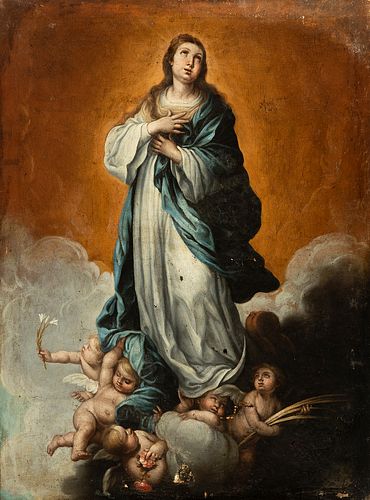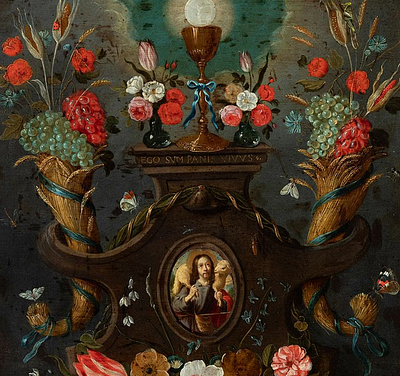School of BARTOLOME ESTABAN MURILLO; early 18th century. "Immaculate Conception". Oil on canvas.
Lot 19
About Seller
Setdart Auction House
Carrer Aragó 346
Barcelona
Spain
Setdart Subastas was born in 2004 and is currently the first online art auction in Spain with solidity, prestige and reliability guaranteed by our more than 60,000 users. Setdart has a young, dynamic and enterprising team ready to successfully manage the purchase and sale of art works through custom...Read more
Estimate:
EUR€900 - EUR€1,000
$937.50 - $1,041.67
Absentee vs Live bid
Two ways to bid:
- Leave a max absentee bid and the platform will bid on your behalf up to your maximum bid during the live auction.
- Bid live during the auction and your bids will be submitted real-time to the auctioneer.
Bid Increments
| Price | Bid Increment |
|---|---|
| EUR€0 | EUR€10 |
| EUR€200 | EUR€25 |
| EUR€500 | EUR€50 |
| EUR€1,000 | EUR€100 |
| EUR€3,000 | EUR€200 |
| EUR€5,000 | EUR€500 |
| EUR€10,000 | EUR€1,000 |
| EUR€20,000 | EUR€2,000 |
| EUR€50,000 | EUR€5,000 |
About Auction
By Setdart Auction House
Sep 21, 2021
Set Reminder
2021-09-21 10:00:00
2021-09-21 10:00:00
America/New_York
Bidsquare
Bidsquare : 21st September - ARAS JÁUREGUI Private Collection - Old Masters, 19th & 20th Century
https://www.bidsquare.com/auctions/setdart-auction-house/21st-september---aras-j-uregui-private-collection---old-masters-19th-20th-century-7429
Setdart Auction House sofia@setdart.com
Setdart Auction House sofia@setdart.com
- Lot Description
School of BARTOLOME ESTABAN MURILLO; early 18th century. "Immaculate Conception". Oil on canvas. It conserves the original canvas. Measurements: 55,5 x 49,5 cm. The theme of the Immaculate Conception, very frequent in the Spanish art, became one of the national identity signs of Spain as a catholic country. It is one of the most genuinely local themes in Spanish Baroque painting, given that our country was the main defender of this mystery, and the one that fought most insistently to make it a dogma of faith. In this context, numerous artists and intellectuals worked to construct a clear iconography that would help to spread the Immaculate Conception, bringing together symbolism and popular fervour. Due to its stylistic characteristics, the work in question can be classified as part of the Andalusian school of the late second half of the 18th century. It is a direct heir to the Baroque models of Bartolomé Esteban Murillo, both in terms of composition and iconography. Thus, we see Mary dressed in a white tunic, wearing a blue mantle that floats around her. The figures of the child angels also derive directly from Murillo's models, both in their conception and in their placement, distributed in the lower part of the painting, under the pedestal of clouds. As we have already noted, the composition faithfully follows the established models of the Baroque period: Mary full-length in the centre, dressed in white and blue, with her hair flowing in soft undulations, with the crescent moon at her feet, surrounded by angels and clouds, with the open sky behind her figure, flooded by the golden light of Glory. Little is known of Murillo's childhood and youth, except that he lost his father in 1627 and his mother in 1628, for which reason he was taken into the care of his brother-in-law. Around 1635 he must have begun his apprenticeship as a painter, most likely with Juan del Castillo, who was married to a cousin of his. This working and artistic relationship lasted about six years, as was customary at the time. After his marriage in 1645 he embarked on what was to be a brilliant career that gradually made him the most famous and sought-after painter in Seville. The only trip he is known to have made is documented in 1658, when Murillo was in Madrid for several months. It is conceivable that while at court he kept in touch with the painters who lived there, such as Velázquez, Zurbarán and Cano, and that he had access to the collection of paintings in the Royal Palace, a magnificent subject of study for all the artists who passed through the court. Despite the few documentary references to his mature years, we know that he enjoyed a comfortable life, which enabled him to maintain a high standard of living and have several apprentices. The fact that he became the leading painter in the city, surpassing even Zurbarán in fame, motivated his desire to raise the artistic level of local painting.
- Shipping Info
-
In-house shipping available. Please inquire at admin@setdart.com.
-
- Buyer's Premium



 EUR
EUR CAD
CAD AUD
AUD GBP
GBP MXN
MXN HKD
HKD CNY
CNY MYR
MYR SEK
SEK SGD
SGD CHF
CHF THB
THB

















